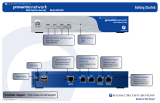
Contents
FortiGate-500A Installation Guide 01-28005-0101-20041015 3
Table of Contents
Introduction ............................................................................................................ 5
Secure installation, configuration, and management .......................................................... 6
Web-based manager ...................................................................................................... 6
Command line interface .................................................................................................. 7
Setup wizard ................................................................................................................... 7
Document conventions ....................................................................................................... 7
Fortinet documentation ....................................................................................................... 9
Comments on Fortinet technical documentation............................................................. 9
Customer service and technical support........................................................................... 10
Getting started ..................................................................................................... 11
Package contents ............................................................................................................. 12
Mounting ........................................................................................................................... 12
Turning the FortiGate unit power on and off ..................................................................... 13
Connecting to the web-based manager............................................................................ 14
Connecting to the command line interface (CLI)............................................................... 15
Factory default FortiGate configuration settings ............................................................... 16
Factory default NAT/Route mode network configuration .............................................. 17
Factory default Transparent mode network configuration............................................. 18
Factory default firewall configuration ............................................................................ 18
Factory default protection profiles................................................................................. 19
Planning the FortiGate configuration ................................................................................ 20
NAT/Route mode .......................................................................................................... 20
NAT/Route mode with multiple external network connections...................................... 21
Transparent mode......................................................................................................... 22
Configuration options .................................................................................................... 22
Next steps ......................................................................................................................... 23
NAT/Route mode installation.............................................................................. 25
Preparing to configure the FortiGate unit in NAT/Route mode ......................................... 25
DHCP or PPPoE configuration ..................................................................................... 26
Using the web-based manager ......................................................................................... 27
Configuring basic settings............................................................................................. 27
Using the front control buttons and LCD........................................................................... 28
Using the command line interface..................................................................................... 29
Configuring the FortiGate unit to operate in NAT/Route mode ..................................... 29
Using the setup wizard...................................................................................................... 32
Starting the setup wizard .............................................................................................. 33
Connecting the FortiGate unit to the network(s) ............................................................... 34
Configuring the networks .................................................................................................. 35
Next steps ......................................................................................................................... 35






















